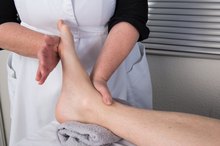Causes of Bilateral Lower Leg Pain
Bilateral lower leg pain is pain in both legs, anywhere between the knees and the ankles. According to MayoClinic.com, leg pain can manifest anywhere from the hips to the ankles, and it may be caused by structures or tissues in other parts of the body, such as the lower back or feet 1. The lower leg is the area between the knees and the ankles. Some conditions can cause pain to arise in the lower leg on both sides of the body.
If you are experiencing serious medical symptoms, seek emergency treatment immediately.
Lumbar Spinal Stenosis
Lumbar spinal stenosis can cause bilateral lower leg pain 2. According to the American Academy of Orthopaedic Surgeons or AAOS, spinal stenosis is a narrowing of the spinal canal, which in turn reduces the amount of space surrounding the spinal cord 2. Over time, as bony changes occur in the vertebrae of the lumber spine or lower back, the spinal canal narrows and puts pressure on the spinal cord or the spinal nerve roots, which may cause:
- pain
- numbness
- weakness in the lower legs
The most common causes of lumbar spinal stenosis are degenerative disc disease and osteoarthritis, which may cause the spinal ligaments to thicken, further reducing the amount of available space for the spinal cord and the spinal nerve roots. Pressure on the spinal cord can cause symptoms in both legs. Common signs and symptoms associated with lumbar spinal stenosis include back pain, burning pain in the lower legs, numbness, tingling and weakness in the lower extremities. The pain can usually lessens when sitting or leaning forward.
- Lumbar spinal stenosis can cause bilateral lower leg pain 2.
- Over time, as bony changes occur in the vertebrae of the lumber spine or lower back, the spinal canal narrows and puts pressure on the spinal cord or the spinal nerve roots, which may cause: * pain
* numbness
* weakness in the lower legs The most common causes of lumbar spinal stenosis are degenerative disc disease and osteoarthritis, which may cause the spinal ligaments to thicken, further reducing the amount of available space for the spinal cord and the spinal nerve roots.
Shin Splints
What Are the Causes of a Throbbing Pain in the Thigh Area?
Learn More
The MedlinePlus website states that shin splints, also called medial tibial stress syndrome, cause pain in the anterior, or front, portion of the lower legs. Shin splint-related pain usually manifests along the edge of the tibia bone--the larger of the two bones of the lower leg.
Shin splints usually develop during or immediately following an increase in exercise volume or intensity. Shin splint-related pain occurs when the muscles, tendons and the thin layer of tissue surrounding the tibia experience swelling and inflammation. Common signs and symptoms associated with shin splints include pain and tenderness along the shin, minor swelling in the affected area and a reduced ability to walk or run. According to the MedlinePlus website, shin splints are a common injury among both recreational and trained athletes alike.
- The MedlinePlus website states that shin splints, also called medial tibial stress syndrome, cause pain in the anterior, or front, portion of the lower legs.
- Common signs and symptoms associated with shin splints include pain and tenderness along the shin, minor swelling in the affected area and a reduced ability to walk or run.
Peripheral Artery Disease
Peripheral artery disease can cause bilateral lower leg pain. Plaque is a combination of fatty and fibrous tissues. A buildup of plaque is called atherosclerosis. Atherosclerosis can cause the arteries, including the arteries carrying oxygenated blood to the lower legs, to harden and narrow. The NHLBI states that peripheral artery disease most commonly affects the legs, although it can also limit blood flow to the head, arms, kidneys and stomach. Common signs and symptoms associated with peripheral artery disease include painful cramping in the hip, thigh or calf muscles following activity, leg numbness and weakness, leg discoloration and a reduced ability to heal wounds in the legs and feet.
- Peripheral artery disease can cause bilateral lower leg pain.
- Atherosclerosis can cause the arteries, including the arteries carrying oxygenated blood to the lower legs, to harden and narrow.
Related Articles
References
- MayoClinic.com: Leg Pain
- American Academy of Orthopaedic Surgeons: Lumbar Spinal Stenosis
- National Heart Lung and Blood Institute: What Is Peripheral Arterial Disease?
- American College of Rheumatology. Spinal Stenosis. Updated March 2019.
- American Academy of Orthopaedic Surgeons. Lumbar Spinal Stenosis. Updated December 2013.
- Lee SY, Kim T-H, Oh JK, Lee SJ, Park MS. Lumbar Stenosis: A Recent Update by Review of Literature. Asian Spine J. 2015 Oct;9(5):818-28. doi:10.4184/asj.2015.9.5.818
- Akhavan-Sigari R, Rohde V, Alaid A. Cervical Spinal Canal Stenosis and Central Disc Herniation C3/4 in a Man with Primary Complaint of Thigh Pain. J Neurol Surg Rep. 2013 Dec;74(2):101-4. doi:10.1055/s-0033-1349202
- Takenaka S et al. Neurological Manifestations of Thoracic Myelopathy. Arch Orthop Trauma Surg. 2014 Jul;134(7):903-12. doi:10.1007/s00402-014-2000-1
- American College of Rheumatology. Spinal Stenosis. Updated March 2019.
- Issack PS, Cunningham ME, Pumberger M, Hughes AP, Cammisa FP. Degenerative lumbar spinal stenosis: evaluation and management. J Am Acad Orthop Surg. 2012;20(8):527-35. doi:10.5435/JAAOS-20-08-527
Writer Bio
Martin Hughes is a chiropractic physician, health writer and the co-owner of a website devoted to natural footgear. He writes about health, fitness, diet and lifestyle. Hughes earned his Bachelor of Science in kinesiology at the University of Waterloo and his doctoral degree from Western States Chiropractic College in Portland, Ore.









